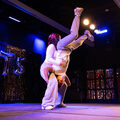Opinion: Weakened Marshall Street bar scene undermines SU’s social rebrand

With the rise in admissions at SU, bars on Marshall Street inevitably have become more crowded. Our columnist argues robust nightlife and strong academics can coexist, despite SU's desire to stray away from its "party school" label. Emily Steiberger | Daily Orange File Photo
Get the latest Syracuse news delivered right to your inbox.
Subscribe to our newsletter here.
It’s a common occurrence for Marshall Street to become a massive traffic jam of people. Lines often wrap around the street, and students sometimes wait up to 30 minutes just to enter a single bar.
When nearly 17,000 undergraduate students from Syracuse University and SUNY ESF share the same standard bar district, overcrowding is inevitable. What should function as a standard college bar district now operates past its capacity.
The issue isn’t rising student interest but a shrinking number of venues, leaving a handful of bars to absorb the social needs of an entire college town.
Syracuse appears to have far fewer student-oriented bars per undergraduate than comparable universities. Peer institutions typically have a much less strained ratio. Even allowing for the fact that most undergraduates aren’t 21 years old, the gap between students and bars remains substantial.
SU is attempting to increase enrollment and rebrand its public image, but the decline of the surrounding bar scene neglects the basic social infrastructure a campus of this size requires. The result is an overcrowded nightlife district, limited social spaces for students not affiliated with organizations and an environment that runs counter to the student experience SU should be building.
In the 1990s, SU enrolled roughly 11,000-12,000 undergraduates and supported about 10 bars on and around Marshall Street. The ratio of roughly one bar per 1,300-1,500 students matched the campus size and kept the Hill’s nightlife functional.
That balance began to break in the 2000s, though. Enrollment rose to around 14,000. Conversely, bars began closing as redevelopment, rising rents and enforcement pressure made it increasingly difficult for small, independent operators to stay. By 2010, the number of active bars had dropped to five or six, and the student-to-bar ratio had already tightened to roughly one bar per 2,500-3,000 students.
The most significant contraction came in the 2010s. Enrollment increased, yet more landmark bars disappeared. The demolition of the original Hungry Chuck’s in 2017 and the closure of DJ’s shortly afterward removed two of the only large-capacity venues left.
The issue isn’t rising student interest but a shrinking number of venues, leaving a handful of bars to absorb the social needs of an entire college town.Dennis Disantis, Columnist
By the mid-to-late 2010s, only about five student bars remained, resulting in roughly one bar for every 3,500-4,500 students, more than double the ratio of the 1990s.
Over the past two decades, SU has steadily expanded its financial control over the Hill. The university and its real-estate partners have acquired increasing portions of Marshall Street and the surrounding commercial corridors, positioning themselves as the dominant landlords in an area once defined by independent operators.
The clearest example was the original Hungry Chuck’s, which was unable to remain in its space once the building was slated for demolition to make way for the now-Milton Hall student apartment complex. With the property being torn down, Chuck’s had no viable path to renew its lease and was effectively forced out by the redevelopment.
As property values rose and redevelopment projects accelerated, student bars and small businesses were among the first businesses displaced. Taken together, these closures suggest a deliberate strategy by the university to reconfigure the Hill in line with its administrative objectives, with these businesses being increasingly viewed as incompatible with that vision.
As SU’s nightlife infrastructure shrank, the university increasingly distanced itself from the “party school” label. After being ranked No. 1 by The Princeton Review in 2014, SU insisted it doesn’t “aspire to be a party school,” making its discomfort with the reputation clear. But the schools SU should look up to academically show that robust nightlife and strong academics can coexist without conflict.
The University of Virginia, for example, enrolls nearly 18,000 undergraduates and supports at least 11 student-oriented bars within its corner district with roughly one bar for every 1,600 students. None of which has harmed UVA’s academic reputation, as proven by its U.S. News & World Report ranking in the top five public schools. The contrast makes SU’s posture toward nightlife appear less like a principled academic stance and more like an effort to control the commercial landscape around campus. And, as usual, the students are the ones who absorb the consequences.
But the disconnect runs deeper than reputation management. If SU truly wants to grow as an institution, it can’t continue to ignore the basic infrastructure contributions to a college experience. A university of nearly 17,000 students can’t operate with a nightlife district built for half that number. The current system is structurally mismatched with the scale of the student body that SU claims to want to attract.
This is where the university’s approach becomes self-defeating. The constriction of the very spaces where students gather and socialize undermines the overall experience that SU should be improving. The university can market new residence halls, new student centers and new branding campaigns, but if the surrounding environment can’t support the daily lived experience of its students, those investments are unlikely to deliver what SU hopes for.
Dennis DiSantis is a senior majoring in political science. He can be reached at dadisant@syr.edu.





